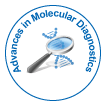Research Article
Double Expression of Epidermal Growth Factor Receptor and N-Glycolyl GM3 Ganglioside in Human Malignant Tumors: A Study in Four Different Clinical Scenarios
Rancés Blanco1*, Mercedes Cedeño1, Charles E Rengifo2, Damián Blanco3, Milagros Frometa1, Elizabeth Domínguez4, Mayra Ramos-Suzarte5, Adriana Carr6 and Enrique Rengifo11Center of Molecular Immunology, P.O. Box 16040, 216 St. and 15 Ave., Atabey, Playa, 11600 Havana, Cuba
2Department of Pathology, National Institute of Oncology and Radiobiology, 29 and F St., Vedado, Plaza de la Revolution, 10400 Havana, Cuba
3Department of Cell Biology and Tissues Banking, National Institute of Oncology and Radiobiology, 29 and F St., Vedado, Plaza de la Revolution, 10400 Havana, Cuba
4Laboratory of Biochemistry, Center of Molecular Immunology, P.O. Box 16040, 216 St. and 15 Ave., Atabey, Playa, 11600 Havana, Cuba
4Clinical Trials Direction, Center of Molecular Immunology, P.O. Box 16040, 216 St. and 15 Ave., Atabey, Playa, 11600 Havana, Cuba
4System Biology Direction, Center of Molecular Immunology, P.O. Box 16040, 216 St. and 15 Ave., Atabey, Playa, 11600 Havana, Cuba
- *Corresponding Author:
- Rancés Blanco
Laboratory of Recognition and Biological Activity Assays
Center of Molecular Immunology, P.O. Box 16040
216 St. and 15 Ave., Atabey, Playa, 11600 Havana, Cuba
Tel: (537) 27179333464
E-mail: rances@cim.sld.cu
Received date: December 23, 2016; Accepted date: February 20, 2017; Published date: February 28, 2017
Citation: Blanco R, Cede脙茠脗卤o M, Rengifo CE, Blanco D, Frometa M, et al. (2017) Double Expression of Epidermal Growth Factor Receptor and N-Glycolyl GM3 Ganglioside in Human Malignant Tumors: A Study in Four Different Clinical Scenarios. Adv Mol Diag 2: 112.
Copyright: © 2017 Blanco R, et al. This is an open-access article distributed under the terms of the Creative Commons Attribution License, which permits unrestricted use, distribution, and reproduction in any medium, provided the original author and source are credited.
Abstract
The interaction between the epidermal growth factor receptor (EGFR) and N-glycolyl GM3 ganglioside (NeuGcGM3) and its contribution to the progression of tumors have been previously described. However, studies concerning to the double expression of EGFR and NeuGcGM3 in human tissues are scarce. Here, it was evaluated by immunohistochemistry the dual expression of EGFR and NeuGcGM3 in 153 samples of malignant tissues grouped as follow: primary tumors, metastasis, conventionally pre-treated samples and recurrent diseases. The presence of both molecules was evidenced in 60/101 (59.4%) and 18/26 (69.2%) of untreated primary tumors and metastasis, respectively. Remarkably, the dual of EGFR and NeuGcGM3 was statistically significant increase in high grade astrocytoma (22/31) when compared with low-grade astrocytomas (0/14) (p=0.000; Chi-square Test). In this type of samples, the expression of EGFR was observed as a finely granular precipitate located in the plasmatic membrane of malignant , while NeuGcGM3 was located in the cell membrane but also in the cytoplasm of tumour cells. The double expression of these tissue antigens was detected in 14/20 (70.0%) of cases that received standard chemotherapy and/or radiotherapy schemes after the surgical removal of tumors. Interestingly, the expression pattern of EGFR and NeuGcGM3 after conventional treatment was similar to those observed in the rest of non-treated samples. Moreover, preliminary data revealed the dual appearance of these molecules in 4/6 (66.7%) of tumor recurrences. All these facts could support the potential design of combined immunotherapy schemes targeting simultaneously both EGFR and NeuGcGM3 in these clinical situations.
